Expanding Utilization of Roots, Tubers and Bananas and Reducing Their Postharvest Losses (RTB-ENDURE) is a 3 year project (2014-2016) implemented by the CGIAR Research Program on Roots, Tubers and Bananas (RTB) with funding by the European Union and technical support of IFAD. http://www.rtb.cgiar.org/endure
I. Introduction
Sweetpotato is the third most important food crop after cassava and bananas in Uganda. Currently, sweetpotato is number one food crop in the Lake Victoria region. Uganda is now the leading producer of sweetpotato in Africa, and second only to China in the world. Increased production has been achieved more from area under cultivation than from increased yields, which over the past decade have remained fairly consistent at a national average of approximately 4.5 tons per hectare. The crop has potential benefits to poor farm households and urban consumers especially when other crops fail or in specific seasons before the main harvest.
Importance of sweetpotato
- Sweetpotato is currently being developed as a means to address one of the most serious health and nutrition problems of Uganda, Vitamin A deficiency which is a major risk factor for pregnant and lactating women. The Orange Fleshed Sweetpotato (OFSP) cultivars contain particularly high levels of carotenoids and are equaled only by carrot as a source of pro-vitamin A. Sweetpotato tubers provide a source of carbohydrates, calcium, ascorbic acid (vitamin C).
- Sweetpotato roots may be eaten boiled, steamed or processed into simple products such as chips, bread, local brew/drink, juice, pancakes and composite flour (mixed with maize, millet and soya flour).
Some of the products from sweetpotates
In some communities, tender (young) sweetpotato leaves are consumed as a vegetable.
Food security crop and cash crop in urban markets in other districts.
Sweetpotato contributes about 20% of total crop residues provided by vines, non- commercial sweetpotato roots, peels which are very good source of livestock feed.
Sweetpotato residues (small roots and vines) can be fed to livestock (pigs, goats, sheep, rabbits and cattle) and in the processed vines and roots can be chopped into small pieces made into silage to feed livestock.
Studies conducted at the National Livestock Resources Research Institute showed that sweet potato vine-based partial milk diets can be used as substitutes to reduce the cost of rearing a calf without adversely affecting its health and yet save more milk for consumption and processing.
Constraints to production and marketing of sweet potatoes
(a) Production constraints:
- sweet potato weevils
- drought
- lack of planting materials
- labour shortage
- lack of farm implements
- land scarcity
- low soil fertility
- vertebrate pests of moles, rats and pigs
(b) Marketing and post-harvesting handling constraints:
- low price
- lack of market
- high labour costs
- unavailability of transport
- information on processing
- weather fluctuations
- inadequate marketing system
- labour shortage in processing
II. Sweetpotato crop production and management
Sweetpotato varieties
Major sweetpotato varieties in Uganda include Orange Fleshed Sweet Potatoes, Ejumule, NASPOT, Dimbuka, Rangira, Bwanjule, New Kawogo, Tanzania, and Wagabolige. Preference depends on sweetness, lack of fibres, in-ground storability, early maturing, drought tolerance and tolerance to diseases. Table 1 shows average tuber yield of some of the varieties in Uganda.
Table 1: Average tuber yield (kg/acre) of some of the sweet potato varieties in Uganda
Variety: SPK 004
Popular name: Kakamega
Mean yield (tons/acre):9.5
Variety: NASPOT 9-O
Popular name: Vita
Mean yield (tons/acre):10.4
Variety: Ejumula
Popular name: Ejumula
Mean yield (tons/acre):6.0
Variety: NASPOT 10-O
Popular name: Kabode
Mean yield (tons/acre):8.5
Variety: Vitamin A sweet potato
Popular name: Orange fleshed sweet potato
Mean yield (tons/acre):12

Soil requirements
- The crop grows on a variety of soils, but well drained light and medium textured soils with a pH range of 5.5-7.0 are more favorable.
- A well distributed rainfall of 750–1000 mm per year is considered most suitable for the crop with a minimum of 500 mm in the growing season.
- The site should be at least 50 meters away from old sweetpotato crop to minimize spread of pests and diseases from old to new crop.
• Sandy loam soils give the best yields. In a proper crop rotation, sweet potato can follow either cereals such as maize, sorghum, rice, finger millet or legumes such as beans.
Land preparation
- Land preparation is done using either a hand hoe or oxen/tractor drawn plough. The operation aims at turning over the topsoil so that plant residues are incorporated in the soil.
- Deep cultivation (at least 15cm) improves the oxygen supply in the soil, thus favoring the growth of bacteria that help in decomposing organic matter.
- The compacted parts that have been trampled by humans, animals and tractor become loose again, thus increasing aeration, water infiltration and good drainage.Selection of planting material
- Sweetpotatoes are grown from vines which are normally cut from a sweetpotato garden or sprouts from old sweetpotato gardens.
- It is recommended to select planting material from healthy vigorous crop (2-3 months old), vines from old crop produce a less vigorous crop and poor yield.
- Cut the top 30cm of the vine for best results. The middle part of the stem can also be used if there is shortage of planting material.
- Plant the vines within 7 days after cutting to avoid loss in quality.
- If not planted on time, cuttings can be stored under shade or in a cool well aerated place. During storage roots develop at the base of the cuttings, the vines harden and establishment becomes faster.
- Fertilizer application
- Organic fertilizers (composted manure, green manure) releases nutrients slowly and therefore should be applied as a basal fertilizer (incorporated when making mounds or ridges).
- During growing period, the plants form dense foliage with rapid vine growth. .Planting time, methods and plant population
- Sweetpotatoes are planted at the beginning of the rain season to get best results,
- The vines are grown on mounds and ridges of varying sizes. A mound should be 100cm wide and 60cm high, the distance between mounds should be 1m. Ridges are spaced at 0.5m from each other.
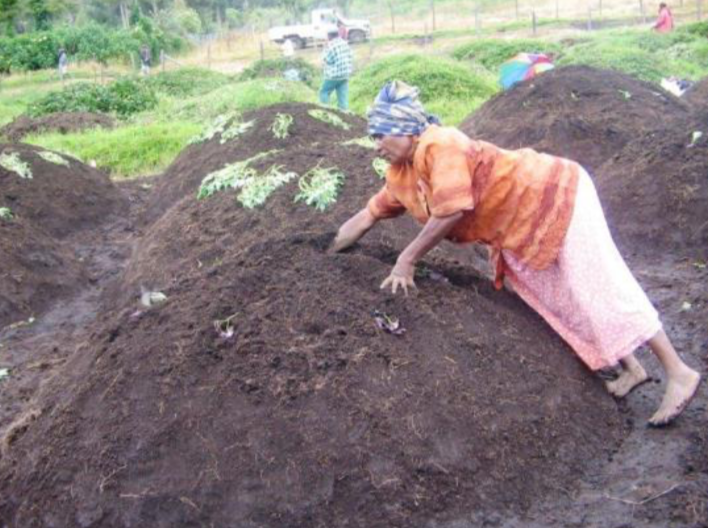
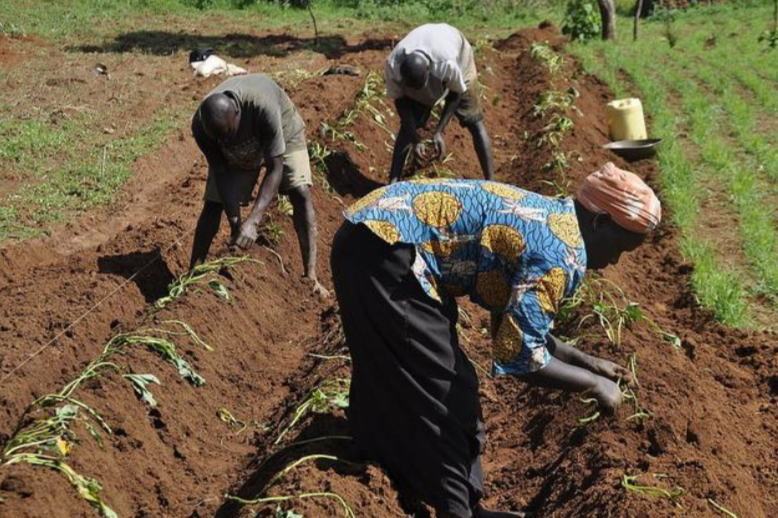
The planting operation involves pushing the lower part of the vine cuttings into the soil, such that they are nearly horizontal. Three vines are planted per mound (4-5 vines can be planted on extremely large mounds like in Buganda). Vines are spaced 30cm from each other on mounds or ridges.
Weeding
- With adequate soil moisture and good soil fertility, sweetpotato vines will cover a large area within one month.
- Thoroughly weed your sweetpotatoes twice; within one month after planting and two months after planting by pulling them gently; if possible avoid deep digging with a hoe or other tool that disturbs the feeder roots that quickly spread throughout the bed.
- Water is especially important as plants grow and roots spread.Sweetpotato pests
• Sweetpotato production can be constrained by pests and viral diseases that cause yield reductions, potentially from about 50 percent to even as much as seventy percent.
(a) Sweetpotato weevil
The sweetpotato weevil is the most serious insect pest of sweetpotatoes worldwide.
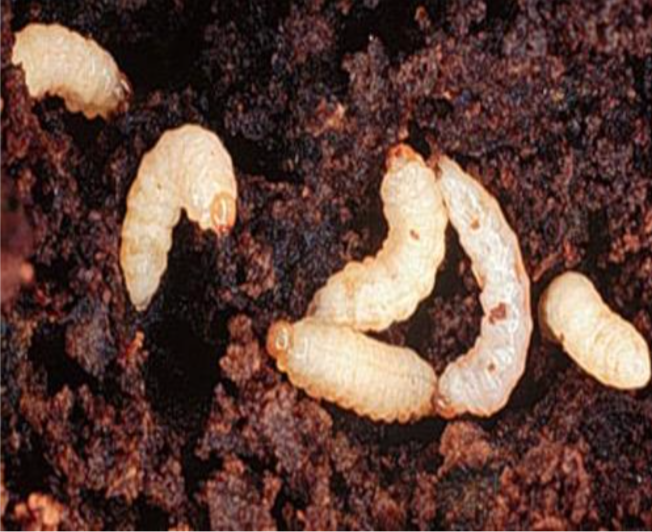

(b) Sweetpotato hornworm
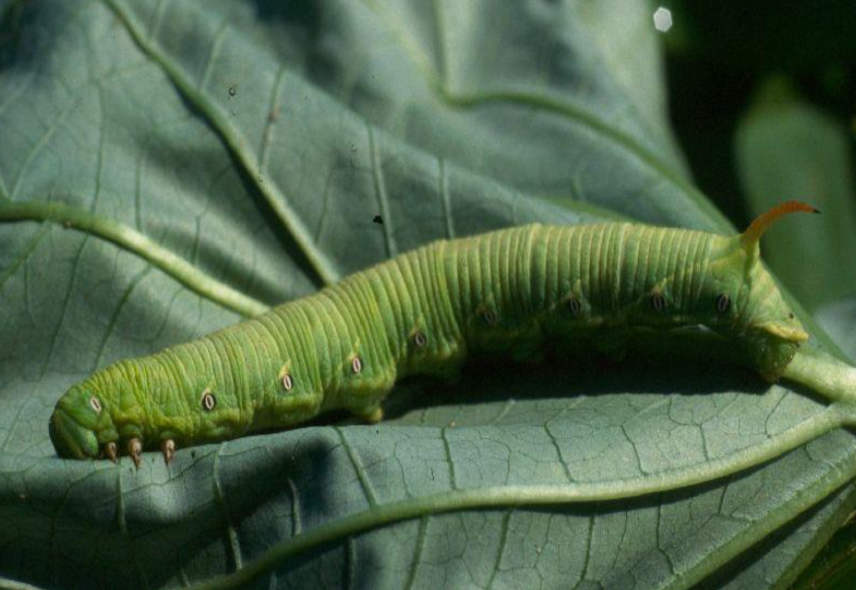
Sweetpotato diseases
Several viruses currently recognized as significant constraints to sweet potato (SP) in Uganda, listed roughly by their frequency of occurrence, include:
(a) Black rot
Black rot is caused by the seed-borne fungus Ceratocystis fimbriata. Symptoms include
large circular, brownish to black, firm, dry rots on sweet potatoes.
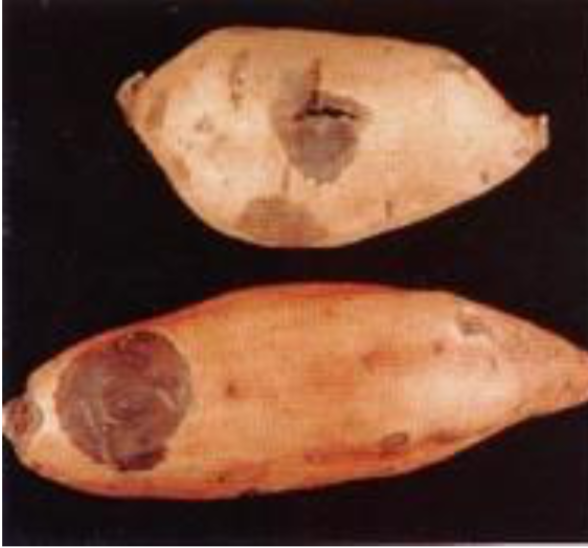

- Stunted plants;
- ▪ wilting plants;
- ▪ yellowing plants;
- ▪ dropping leaves;
- ▪ plant death;
- ▪ circular brown-black patches of rot on tubers
In plant beds symptoms include plant stunting, wilting, yellowing, leaf drop, and plant death. Rots may continue developing in storage. Infected roots have a bitter taste. Management: Avoid infected seed roots. Cut transplants above the soil line. Rotate with other crops in a 2 to 3 year rotation. Treat seed roots with a fungicide
(b) Ring rot
Ring rot is caused by the common, soil-borne fungus Pythium spp., which also parasitizes many other plants. Infected roots have sunken, chocolate colored lesions that tend to extend laterally and often form a ring around the sweet potato.

The soft rot extends into the interior as illustrated. Losses generally occur late in the season during cool, rainy periods. Symptoms may be confused with Rhizopus and bacterial soft rots and souring. Ring rot usually does not spread in storage. The disease can be managed by harvesting prior to cool, wet periods.
(c) Fusarium root and stem rot
Fusarium root and stem rot, caused by the fungus Fusarium solani, is a common field and storage rot. The rot extends deep into the sweetpotato and is firm and dark tan in color. Internally, elliptical cavities form in which a white mold develops.
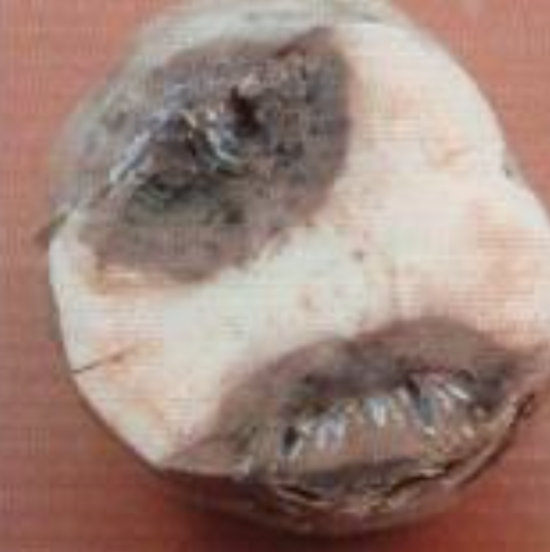
The soil-borne disease may be spread by infected transplants. The base of mature stems may become swollen and distorted.
Generally, pests and diseases can be managed by applying integrated pest management (IPM) methods. These include: (a) planting healthy vines, (b) planting a new crop 50m away from the old field, (c) early planting, crop rotation, (d) destruction of infested plant parts and (e) destroy volunteer crops.
III. Harvesting, consumption, storage and marketing
Harvesting for quality
Sweetpotatoes are usually ready to harvest just as the ends of the vines begin to turn yellow, or about 4-5 months after planting depending on variety. To avoid injuring roots, find the primary crown of the plant you want to dig, and then use a digging fork to loosen an 18-inch wide circle around the plant. Pull up the crown and use your hands to gather your sweetpotatoes. To make digging easier and get the vines out of your way, you can cut some of them away before digging.
Harvesting the roots in piecemeal (removing big roots and creating room for small ones) can start at 3 to 4 months. Wholesale harvesting takes place when the crop is mature (4-6 months)
Consumption
Sweetpotato is generally consumed in fresh form, but where weevil attacks limit the length of time that roots can be kept underground prior to harvesting, they can be harvested, chipped, and sun-dried to make products such as inginyo and amukek. Sweetpotatoes can be baked, roasted processed into dry chips, pounded into powder to make other delicacies like cakes, cookies, pancakes, etc.
Storage and marketing
Sweetpotato roots are bulky and perishable unless cured. This limits the distance over which sweetpotato can be economically transported. Production areas capable of generating surpluses tend to be relatively localized but dispersed, which leads to a lack of market integration and limits market size. Moreover, production is highly seasonal leading to marked variation in the quantity, and quality, of roots in markets and associated price swings. There is little commercial processing into chips or flour, which could be stored for year round consumption for use in ugali, bread and cakes, or processing into fermented and dried products like fufu. Sweetpotato consumption tends to decline as incomes rise, a change often linked with urbanization, partly because it is perceived as a “poor man’s food” butmostly because of the change in relative prices of root crops compared to grains in urban areas due to transport cost differentials.
- Roots can be stored in the ground for an additional period but they are attacked by weevils when soil is dry and cracked. This leads to a marked seasonality of supply with substantial price variability and deterioration in quality as the dry season progresses. Seasonality of supply creates a barrier to increasing per capita consumption and income earning possibilities both for fresh sales and for processing.
- Farmers have developed “In ground storage and piecemeal harvesting” technology to maintain the supply of fresh sweetpotato for as long as possible. In Uganda this involves staggered planting, so that crop will not all mature simultaneously, and in ground storage of roots after maturity, for up to six months. Piecemeal harvesting is an indigenous practice which may reduce weevil losses as more superficial and potentially damaged roots are harvested first.
- Farmers in areas with marked dry seasons in Uganda sun dry sweetpotato to extend the period when it may be consumed. In Uganda, roots are sliced (amokeke) or crushed (inginyo) before drying. Amokeke is reconstituted whole as a breakfast food and inginyo used for flour to produce atapa, a starchy staple.
- In Tanzania roots are sliced fresh or after boiling before drying. These products can be stored for six months.
- Dried products are mostly used for home consumption with limited commercialization, probably because they are not competitive with dried cassava chips. Slicing and drying by hand is labor intensive for processing large quantities when fresh storage would be preferable, but is an option for dealing with small quantities at a time. If farmers could store fresh roots they could benefit from higher prices at the end of the harvest season.
- Sweetpotato can be chipped and dried. At the village level, women slice the sweetpotato into thin round chips by hand. Commercially oriented operations require an investment in chippers, with manual, bicycle driven and motorized versions available, and drying racks.
- Dried chips can be milled to make sweetpotato flour. This adds more value for farmers, and reduces volume for transportation, and was financially viable in a pilot trial. But it is difficult for farmers to maintain quality (a) because they cannot determine moisture content and may mill chips which are not properly dried and (b) it may contain impurities as farmers use public mills.
- The largest flour market is for staples such as ugali. White fleshed sweetpotato flour would have to compete on price and quality with cassava and maize flour in this market. Since fresh sweetpotato tends to sell at a higher price than cassava this could be difficult.
- The best market for sweetpotato flour would be as a substitute for wheat flour in the production of the snack foods, chapattis (flat unleavened bread) and mandazi (doughnuts) and porridge, where sweetness is not an issue.